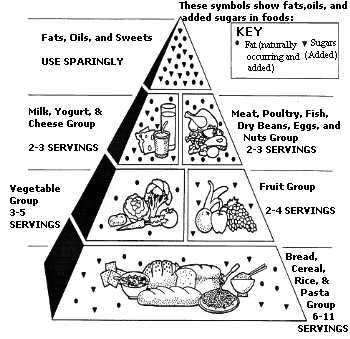Use the Food Guide Pyramid to help you eat better every day, the Dietary Guidelines way. Start with plenty of Breads, Cereals, Rice, and Pasta; Vegetables and Fruits. Add two to three servings from the Milk group and two to three servings from the Meat Group.
Each of these food groups provides some, but not all of the nutrients you need. No one food group is more important than another - for good health you need them all. Go easy on fats, oils and sweets, the foods in the small tip of the Pyramid.
 Discuss the five
food groups of the Food Pyramid.
Discuss the five
food groups of the Food Pyramid.
Identify the five food groups and their location in the pyramid.
How many servings from each food group are recommended?
What are the serving sizes for each food group? (See next page.)
What does the sixth section of the pyramid represent? Why should this section be limited?
Categorize this list of foods into the appropriate location on the pyramid:
chicken salad on whole wheat bread
tossed salad with Russian dressing
peanut butter and jelly sandwich
French toast
beef taco
The number of servings recommended for each food group is based on the number of calories needed to maintain ideal body weight. This varies depending on age, sex, size and activity level. The following chart lists the numbers of servings based on average daily intake for teenagers.
Food Group
Teenage Girls 2200 Calories
Teenage Boys 2800 Calories
Serving Size
Bread servings
9
11
1 slice bread, 1 oz. dry cereal, 1/2 cup cooked cereal, rice or pasta
Vegetable servings
4
5
1 cup raw leafy vegetable; 1/2 cup other vegetables, cooked or chopped raw, 3/4 cup vegetable juice
Fruit servings
3
4
1 medium apple, banana, orange, 1/2 cup chopped, cooked or canned fruit, 3/4 cup fruit juice
Milk servings
2-3
2-3
1 cup milk or yogurt, 1 1/2 oz. natural cheese, 2 oz. process cheese
Meat servings
6 oz.
7 oz.
2-3 cooked lean meat, poultry fish, 1 oz. of lean meat = 1/2 cup dry beans, 1 egg, 2 tablespoons peanut butter
Survey your favorite teenager and see what she ate yesterday. Discuss this graph with her.
Why do you think boys can have more serving sizes and calories?
Can you eat correctly at a fast food place?
Keep a list of the food you eat in one day.
Breakfast
Lunch
Dinner
Snacks
food/food group
food/food group
food/food group
food/food group
Total __________
Total __________
Total __________
Total __________
Make a circle graph to illustrate the percentage of food groups eaten at breakfast, lunch, dinner and as snacks. Learn to use a spreadsheet program to create the graph.
Compare your diet for one day to the following diet recommend to give young people the nourishment they need for growth and good health. Circle all the foods you are that day.
Write the names of the foods for which your consumption was more than necessary; less than suggested. Use the illustrated chart.
_______________ _______________
_______________ _______________
_______________ _______________
_______________ _______________
_______________ _______________
_______________ _______________
_______________ _______________
_______________ _______________
_______________ _______________
_______________ _______________
_______________ _______________
_______________ _______________
What is meant by junk food? ______________________________________________________________
Do you think most people know which foods are considered junk foods? __________ Do you? _________
What are some reasons you think people eat junk food? _________________________________________
Are you giving your inner environment the break it deserves? __________
If not, what should you add to your diet? __________ __________ __________ __________ __________
What should you take away? __________ __________ __________ __________
(Up to Section IV, Back to Eye Opener Activities 10, On to Eye Opener Activities 11)